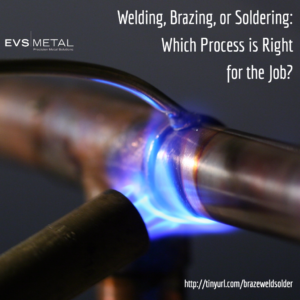Article Revised August 27th, 2022
 There’s often a lack of understanding around what constitutes welding vs. brazing vs. soldering, and for good reason. Each is a method of joining together pieces of a given material, most often metal, but at times thermoplastics and other materials as well. Depending on the situation, any of these could also be used to fill in gaps in stand-alone parts. Adding to the confusion, the term “solder” can also refer to the material itself being used to join parts together, not just the process of joining.
There’s often a lack of understanding around what constitutes welding vs. brazing vs. soldering, and for good reason. Each is a method of joining together pieces of a given material, most often metal, but at times thermoplastics and other materials as well. Depending on the situation, any of these could also be used to fill in gaps in stand-alone parts. Adding to the confusion, the term “solder” can also refer to the material itself being used to join parts together, not just the process of joining.
What major factor sets welding, brazing, and soldering apart?
Let’s start by looking at the basic definitions of each, which illustrate just how much temperature impacts the choice to use one over the others:
Welding: Joins materials via fusion, using either heat, pressure, or a combination of the two. Welding is an extremely high-temperature process (3,000 to 20,000 °C) and therefore results in the melting of the base metal or other material involved. Often, a filler material is added to the joint to form a weld pool, which, when cooled, is stronger than the base material by itself.
Brazing: Like welding, brazing also joins together two materials, often metals, by melting a bonding alloy between them to create a join. Unlike with welding, this process does not melt the base material being brazed as it is a lower temperature technique that can only occur above 840°F (450°C), and below the solidus (the point at which the materials are entirely solid/crystallized) of the base metals.
Soldering: While soldering, like welding and brazing, also joins materials together with fillers, it is accomplished at the lowest temperature of the three joining techniques discussed here — below 840°F (450°C). This temperature does not melt the base metal and makes soldering a good choice for more delicate applications.
Although temperature is a distinguishing characteristic between soldering, brazing, and welding, it’s not the only important factor to consider when choosing a joining method.
Looking for precision sheet metal fabrication and machining services?

What other factors make welding, brazing or soldering better for certain applications?
Let’s start with welding. Welding is the hottest of the three forms of material joining discussed here, and because of that, it creates exceptionally strong joins or connection points. When done correctly, the welded area can be as strong as the metal surrounding it. But the high temperature necessary for welding also means care must be taken not to apply too much heat, as this can change the molecular structure of the metals and actually weaken the weld.
 In fact, welding is such a hot process that it is often used to cut through heavy metal structures, not just join them together. It is also important to note that welding can only be used to join two similar metals together. This is not the case with all joining processes.
In fact, welding is such a hot process that it is often used to cut through heavy metal structures, not just join them together. It is also important to note that welding can only be used to join two similar metals together. This is not the case with all joining processes.
Brazing is another high-heat process that can create joins that are equally strong as the materials being welded. However, brazing does not create joins that are as strong as those resulting from proper welding techniques. This may sound like a bad thing, but not necessarily. Because brazing temperatures are still considerably lower than those required for welding, it is sometimes more appropriate than the at-times extreme heat of welding.
Brazing can also be used to join two dissimilar materials. This is not possible with welding. For instance, many types of cookware are the result of brazing copper or aluminum to stainless steel. Brazing can also join ceramics to metal, and even thin materials to thick.
Soldering is the coolest of the three processes, and creates joins not nearly as strong as those created by welding, or even brazing. However, that makes it an excellent choice when very precise or small joins are necessary. Think of welding as the best option to join together parts of an airplane’s fuselage. Big, strong joins capable of withstanding massive stress are necessary in that case. Soldering, on the other hand, is best for precision work for items like electrical components. Think of the LEDs, transistors, and resistors that make up finished products such as TVs and computers and require a lighter touch.
Understanding welding, brazing, soldering, and their relative strengths and weaknesses is crucial for metal fabrication professionals. While the processes are often confused, awareness and appreciation of their differences are what allows those on the front lines of production to select the right process for the application, ensuring finished products are structurally sound.
Interested in learning more about EVS’s welding capabilities for your next sheet metal fabrication project? Get an online quote, or call 1-888-9EVSMET.




